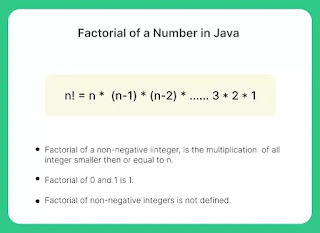A factorial is the product of all positive integers less than or equal to n. For example, the factorial of 5 (written as 5!) is 5 x 4 x 3 x 2 x 1 = 120. The symbol for factorial is an exclamation mark (!).
In mathematics, the factorial function is commonly used in counting problems and in combinatorics. It also appears in calculus, probability, statistics, and number theory.
To write a program in Java that calculates the factorial of a given number, we can use a for loop and a variable to store the result. Here is an example of such a program:
public class Factorial {
public static void main(String[] args) {
int n = 5; // number for which factorial is to be found
int result = 1;
for (int i = 1; i <= n; i++) {
result *= i;
}
System.out.println(n + "! = " + result);
}
}
In this program, we first declare a variable n that determines the number for which we want to calculate the factorial. We then declare a variable result and initialize it to 1. This variable will be used to store the factorial.
Next, we use a for loop to calculate the factorial. The loop starts at 1 and goes up to n. In each iteration, we multiply the current value of result by the current value of the loop variable i. This way we will calculate the factorial of n.
Finally, we print out the result by concatenating the n and “!” with the result. When you run the code, you’ll see the output is “5! = 120” which is the factorial of 5.
It’s worth noting that this implementation may not be suitable for very large numbers, as the value of n! can be very large and may cause an integer overflow. In those cases, it would be better to use a data type with larger capacity such as long or BigInteger.
This is just one way to write a program to calculate the factorial in Java. There are many other ways to do it, depending on your specific needs and constraints.
It’s also a common practice to implement the factorial function recursively, which is a more elegant and readable method, but it has the risk of stack overflow if the number is very large.

